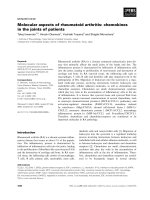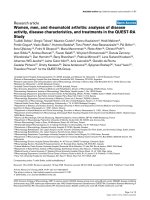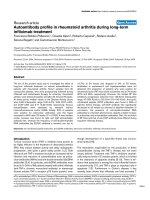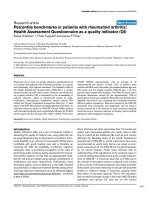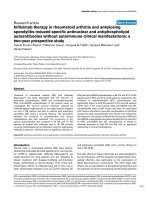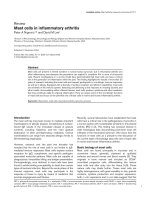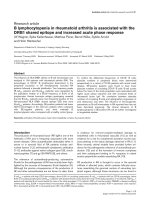Báo cáo y học: "Homing chemokines in rheumatoid arthritis" doc
Bạn đang xem bản rút gọn của tài liệu. Xem và tải ngay bản đầy đủ của tài liệu tại đây (44.95 KB, 4 trang )
233
BCA-1 = B cell-activating chemokine-1 (CXCL13); CCR = CC-chemokine receptor; CXCR = CXC-chemokine receptor; ENA-78 = epithelial–neu-
trophil activating protein-78 (CXCL5); FDC = follicular dendritic cell; GC = germinal centre; IL = interleukin; MCP-1 = monocyte-chemoattractant
protein-1 (CCL2); MIP-1α = macrophage inflammatory protein-1α (CCL3); RA = rheumatoid arthritis; RANTES = regulated upon activation, normal
T cell expressed and secreted (CCL5); RT-PCR = reverse-transcriptase-mediated polymerase chain reaction; SDF-1 = stromal cell-derived factor 1
(CXCL12); SLC = secondary lymphoid tissue chemokine (CCL21); Th = T helper cell.
Available online />Introduction
Rheumatoid arthritis (RA) is an autoimmune disease charac-
terized by chronic inflammation and destruction of the carti-
lage and bone in the joints [1]. Despite the large research
effort, neither the initiating event nor the perpetuating
factors are clearly understood. The characteristic features of
the disease are synovial lining hyperplasia and chronic infil-
tration of inflammatory cells including T lymphocytes, B lym-
phocytes, monocytes/macrophages and granulocytes. The
hyperplastic lining layer is mainly composed of highly acti-
vated macrophage-like cells and proliferating fibroblast-like
cells. The infiltrating lymphocytes are localized in the sublin-
ing tissue and are found around the blood vessels and in
the stroma. Frequently, lymph-node-like aggregates are
observed. Today, it is generally accepted that chemokines
and their receptors are critical for the recruitment and posi-
tioning of cells in the inflamed synovium [2].
The human chemokine system comprises about 50
chemokines and 18 receptors [3–6]. Depending on the
number and spacing of cysteine residues in the NH
2
-
terminal region, chemokines are partitioned into four
structural families (CXC, CC, CX3C and C), and depend-
ing on the their function in inflammation and immunity, they
have recently been grouped into inflammatory (also called
inducible) and homing (also called constitutive, lymphoid
or housekeeping) chemokines. Inflammatory chemokines
are expressed by many different tissue cells and by immi-
grating leukocytes on stimulation with proinflammatory
cytokines and pathogens. The main function of these
chemokines is to recruit effector cells of the innate and
adaptive immune systems, including granulocytes, mono-
cytes, natural killer cells and effector lymphocytes. Homing
chemokines, by contrast, are constitutively expressed in
discrete areas within lymphoid and non-lymphoid tissues.
Such chemokines control the physiological traffic and
homing of leukocytes, which mainly belong to the adaptive
immune system. All chemokines act via seven transmem-
brane domain receptors that are coupled to guanosine-
triphosphate-binding proteins [7].
Chemokines and their receptors in RA
Since it is well known that proinflammatory cytokines
including tumour necrosis factor-α and IL-1β play a
Commentary
Homing chemokines in rheumatoid arthritis
Pius Loetscher and Bernhard Moser
Theodor-Kocher Institute, University of Bern, Switzerland
Corresponding author: Pius Loetscher (e-mail: )
Received: 17 December 2001 Accepted: 15 January 2002 Published: 31 January 2002
Arthritis Res 2002, 4:233-236
© 2002 BioMed Central Ltd (
Print ISSN 1465-9905; Online ISSN
1465-9913)
Abstract
In about 20% of patients with rheumatoid arthritis, B and T lymphocytes recruited into the inflamed
synovium are organized into complex microstructures, which resemble secondary lymphoid organs.
The development of such lymphoid aggregates with germinal centers appears to contribute to the
pathogenesis of the disease. Growing evidence indicates that chemokines and their receptors control
the recruitment and positioning of leukocytes as well as their organization into node-like lymphoid
structures. Here, we comment on recent studies highlighting the importance of chemokines in
rheumatoid arthritis, in particular of B-cell-activating chemokine-1 in lymphoid neogenesis in the
inflamed synovium.
Keywords: BCA-1, chemokine receptors, chemokines, CXCR5, ectopic follicles
234
Arthritis Research Vol 4 No 4 Loetscher and Moser
crucial role in the pathogenesis of RA, it is not surprising
that inflammatory chemokines are found to be abun-
dantly expressed in the inflamed RA synovium [8,9].
Numerous studies have demonstrated that activated syn-
ovial fibroblasts and monocytes/macrophages are the
main producers of chemokines, such as IL-8 (recently
designated CXCL8 [10]), epithelial–neutrophil activating
protein-78 (ENA-78 or CXCL5), monocyte-chemoattrac-
tant protein-1 (MCP-1 or CCL2), RANTES (regulated
upon activation, normal T-cell expressed and secreted or
CCL5) and macrophage inflammatory protein-1α (MIP-
1α or CCL3) in RA synovial tissue, and that elevated
levels of these chemokines are also detected in RA syn-
ovial fluids [9]. IL-8 and ENA-78, which act on granulo-
cytes, and MCP-1, RANTES and MIP-1α, which act
primarily on monocytes and lymphocytes, are involved in
the selective recruitment and activation of these cells.
Recent studies have focused on the analysis of
chemokine receptor expression in RA synovial T lympho-
cytes. The marked expression of the chemokine recep-
tors CXCR3, CXCR6 and CCR5 on memory CD4
+
T
lymphocytes, which represent the predominant infiltrate
the inflamed synovium, is consistent with their highly dif-
ferentiated state [11–16]. These inflammatory
chemokine receptors are prominently expressed on
effector T lymphocytes (Th1 cells) that mediate a type 1
inflammation such as RA. Interestingly, it has also been
demonstrated that the RA synovial memory CD4
+
T lym-
phocytes express high levels of the chemokine receptor
CXCR4, and that the ligand stromal cell-derived factor 1
(SDF-1 or CXCL12) is produced by synovial fibroblasts
and endothelial cells [17,18]. Since CXCR4 expression
is enhanced by IL-15 and transforming growth factor-β,
which are present in the inflamed joint, CXCR4 and
SDF-1 have been suggested to be important in retaining
the cells at this site [17,18].
In about 20% of patients with RA, infiltrating T and B lym-
phocytes accumulate underneath the synovial lining layer
and organize into lymphocyte aggregates with germinal
centres (GCs) [19–21]. These ectopic lymphoid struc-
tures share many features with secondary lymphoid tissue
and are thought to contribute to the pathogenesis of the
disease [22]. Some homing chemokines, which are mainly
expressed in lymphoid tissues, have been implicated in the
formation of lymphoid structures [5,23]. The first indication
of their involvement came from studies of CXCR5 (for-
merly known as Burkitt’s lymphoma receptor-1 [24]),
which is highly selective for the single chemokine B cell-
activating chemokine-1 (BCA-1) [25,26]. The chemokine
receptor CXCR5 is expressed in all circulating mature B
lymphocytes and a subset of memory CD4
+
T lympho-
cytes, whereas the expression of its ligand, BCA-1, is
mainly confined to B-cell follicles [27–30]. Mice deficient
in CXCR5 or B-lymphocyte chemoattractant (the murine
homologue of human BCA-1) have a profound distur-
bance of follicle and GC formation in the spleen and
Peyer’s patches [31,32]. Transgenic expression of BCA-1
in pancreatic islets, on the other hand, was shown to
promote the development of lymph-node-like structures
suggesting that BCA-1 can induce extranodal formation of
organized lymphoid tissue [33]. Lymphoid neogenesis is
not only observed in RA, but also in several other chronic
inflammatory diseases including Helicobacter pylori gastri-
tis, Sjögren’s syndrome, Hashimoto’s thyroiditis and
chronic hepatitis C [21]. It is interesting to note that BCA-
1 expression has been detected in all instances where
extranodal lymphoid structures were examined, including
H. pylori-induced, gastric-mucosa-associated lymphoid
tissue and gastric lymphomas [34] as well as Sjögren’s
syndrome [35,36]. Evidence for the critical involvement of
BCA-1 in the formation of RA-associated follicular aggre-
gates is summarized below.
BCA-1 in RA lymphoid follicle formation
Shi et al. [37] and Takemura et al. [38] have reported that
BCA-1 is expressed in the RA synovium. In both studies,
BCA-1 mRNA was detected in all RA samples by reverse-
transcriptase-mediated (RT)-PCR, but the transcript level
was markedly higher in tissues with GC-positive lymphoid
follicles than in tissues with GC-negative lymphoid follicles
or with a diffuse lymphoid infiltrate. Immunohistochemical
analysis showed that BCA-1 was mainly expressed within
the GC, and the follicular dendritic cells (FDCs) were iden-
tified as cellular source [37,38]. In addition, Takemura et al.
[38] report that endothelial cells lining small arterioles and
capillaries, and synovial fibroblasts in the lining and sublin-
ing tissue stained positive for BCA-1 in samples either with
or without GC-positive follicles. The presence on the
endothelial cells suggests that BCA-1 may also be involved
in transendothelial migration of CXCR5-positive cells [39].
Evidence for a role of other homing chemokines in RA-
associated lymphoid structure formation is less clear. For
instance, ectopic lymphoid tissues were readily observed in
mice carrying a transgene for secondary lymphoid tissue
chemokine (SLC) [40]. In RA synovial tissue, Takemura et
al. [38] detected SLC mRNA by RT-PCR, while Shi et al.
[37] did not confirm these findings by immunohistochemi-
cal analysis of SLC protein expression. Further research is
required to determine whether SLC is important in leuko-
cyte aggregation within the RA synovium.
Intriguingly, a perfect correlation was found between the
occurrence of FDCs and GC-positive follicles in rheuma-
toid synovitis [38]. GCs were observed only when FDCs,
which produce BCA-1, were present in the follicle.
Whether the FDCs develop locally from precursors or
whether they are recruited to this area is not known. In
either case, they are critical for lymphoid neogenesis in
the synovium. Furthermore, the strict requirement of
FDCs suggests that antigen recognition events play a
major role.
235
Conclusion
Clearly, we do not yet understand the mechanisms of
extranodal lymphoid follicle formation in RA. Recent
studies provide evidence that chemokines have an induc-
tive function in establishing these microstructures. The
induction of BCA-1 and other lymphoid-tissue-inducing
chemokines may convert the synovial lesion from an acute
to a chronic state by amplifying antigen-specific
responses. Blocking chemokine activity by means of
chemokine receptor antagonists may thus have significant
therapeutic value.
Acknowledgements
This work was supported by grant 31-55996.98 of the Swiss National
Science Foundation. We thank Marco Baggiolini for critical reading of
the manuscript.
References
1. Harris ED Jr: Rheumatoid arthritis. Pathophysiology and impli-
cations for therapy. N Engl J Med 1990, 322:1277-1289.
2. Godessart N, Kunkel SL: Chemokines in autoimmune disease.
Curr Opin Immunol 2001, 13:670-675.
3. Loetscher P, Moser B, Baggiolini M: Chemokines and their
receptors in lymphocyte traffic and HIV infection. Adv Immunol
2000, 74:127-180.
4. Murphy PM, Baggiolini M, Charo IF, Hebert CA, Horuk R, Mat-
sushima K, Miller LH, Oppenheim JJ, Power CA: International
union of pharmacology. XXII. Nomenclature for chemokine
receptors. Pharmacol Rev 2000, 52:145-176.
5. Moser B, Loetscher P: Lymphocyte traffic control by chemo-
kines. Nat Immunol 2001, 2:123-128.
6. Mackay CR: Chemokines: immunology’s high impact factors.
Nat Immunol 2001, 2:95-101.
7. Thelen M: Dancing to the tune of chemokines. Nat Immunol
2001, 2:129-134.
8. Kunkel SL, Lukacs N, Kasama T, Strieter RM: The role of
chemokines in inflammatory joint disease. J Leukocyte Biol
1996, 59:6-12.
9. Szekanecz Z, Koch AE: Update on synovitis. Curr Rheumatol
Rep 2001, 3:53-63.
10. Zlotnik A, Yoshie O: Chemokines: a new classification system
and their role in immunity. Immunity 2000, 12:121-127.
11. Qin S, Rottman JB, Myers P, Kassam N, Weinblatt M, Loetscher M,
Koch AE, Moser B, Mackay CR: The chemokine receptors
CXCR3 and CCR5 mark subsets of T cells associated with
certain inflammatory reactions. J Clin Invest 1998, 101:746-754.
12. Loetscher P, Uguccioni M, Bordoli L, Baggiolini M, Moser B, Chiz-
zolini C, Dayer J-M: CCR5 is characteristic of Th1 lymphocytes.
Nature 1998, 391:344-345.
13. Mack M, Brühl H, Gruber R, Jaeger C, Cihak J, Eiter V, Plachy J,
Stangassinger M, Uhlig K, Schattenkirchner M, Schlöndorff D:
Predominance of mononuclear cells expressing the chemo-
kine receptor CCR5 in synovial effusions of patients with dif-
ferent forms of arthritis. Arthritis Rheum 1999, 42:981-988.
14. Suzuki N, Nakajima A, Yoshino S, Matsushima K, Yagita H,
Okumura K: Selective accumulation of CCR5
+
T lymphocytes
into inflamed joints of rheumatoid arthritis. Int Immunol 1999,
11:553-559.
15. Kim CH, Kunkel EJ, Boisvert J, Johnston B, Campbell JJ, Gen-
ovese MC, Greenberg HB, Butcher EC: Bonzo/CXCR6 expres-
sion defines type 1-polarized T-cell subsets with
extralymphoid tissue homing potential. J Clin Invest 2001,
107:595-601.
16. Patel DD, Zachariah JP, Whichard LP: CXCR3 and CCR5 ligands
in rheumatoid arthritis synovium. Clin Immunol 2001, 98:39-
45.
17. Buckley CD, Amft N, Bradfield PF, Pilling D, Ross E, Arenzana-
Seisdedos F, Amara A, Curnow SJ, Lord JM, Scheel-Toellner D,
Salmon M: Persistent induction of the chemokine receptor
CXCR4 by TGF-beta 1 on synovial T cells contributes to their
accumulation within the rheumatoid synovium. J Immunol
2000, 165:3423-3429.
18. Nanki T, Hayashida K, El Gabalawy HS, Suson S, Shi K, Girschick
HJ, Yavuz S, Lipsky PE: Stromal cell-derived factor-1-CXC
chemokine receptor 4 interactions play a central role in CD4+
T cell accumulation in rheumatoid arthritis synovium. J
Immunol 2000, 165:6590-6598.
19. Young CL, Adamson TC III, Vaughan JH, Fox RI: Immunohisto-
logic characterization of synovial membrane lymphocytes in
rheumatoid arthritis. Arthritis Rheum 1984, 27:32-39.
20. Wagner UG, Kurtin PJ, Wahner A, Brackertz M, Berry DJ, Goronzy
JJ, Weyand CM: The role of CD8+ CD40L+ T cells in the for-
mation of germinal centers in rheumatoid synovitis. J Immunol
1998, 161:6390-6397.
21. Hjelmstrom P: Lymphoid neogenesis: de novo formation of
lymphoid tissue in chronic inflammation through expression
of homing chemokines. J Leukocyte Biol 2001, 69:331-339.
22. Weyand CM, Goronzy JJ, Takemura S, Kurtin PJ: Cell-cell inter-
actions in synovitis. Interactions between T cells and B cells in
rheumatoid arthritis. Arthritis Res 2000, 2:457-463.
23. Cyster JG: Chemokines and cell migration in secondary lym-
phoid organs. Science 1999, 286:2098-2102.
24. Dobner T, Wolf I, Emrich T, Lipp M: Differentiation-specific
expression of a novel G protein-coupled receptor from Burkit-
t’s lymphoma. Eur J Immunol 1992, 22:2795-2799.
25. Legler DF, Loetscher M, Roos RS, Clark-Lewis I, Baggiolini M,
Moser B: B cell-attracting chemokine 1, a human CXC
chemokine expressed in lymphoid tissues, selectively attracts
B lymphocytes via BLR1/CXCR5. J Exp Med 1998, 187:655-660.
26. Gunn MD, Ngo VN, Ansel KM, Ekland EH, Cyster JG, Williams LT:
A B-cell-homing chemokine made in lymphoid follicles acti-
vates Burkitt’s lymphoma receptor-1. Nature 1998, 391:799-
803.
27. Förster R, Emrich T, Kremmer E, Lipp M: Expression of the G-
protein-coupled receptor BLR1 defines mature, recirculating
B cells and a subset of T-helper memory cells. Blood 1994,
84:830-840.
28. Cyster JG, Ngo VN, Ekland EH, Gunn MD, Sedgwick JD, Ansel
KM: Chemokines and B-cell homing to follicles. Curr Top
Microbiol Immunol 1999, 246:87-92.
29. Schaerli P, Willimann K, Lang AB, Lipp M, Loetscher P, Moser B:
CXC chemokine receptor 5 expression defines follicular
homing T cells with B cell helper function. J Exp Med 2000,
192:1553-1562.
30. Breitfeld D, Ohl L, Kremmer E, Ellwart J, Sallusto F, Lipp M,
Forster R: Follicular B helper T cells express CXC chemokine
receptor 5, localize to B cell follicles, and support
immunoglobulin production. J Exp Med 2000, 192:1545-1552.
31. Förster R, Mattis AE, Kremmer E, Wolf E, Brem G, Lipp M: A
putative chemokine receptor, BLR1, directs B cell migration to
defined lymphoid organs and specific anatomic compart-
ments of the spleen. Cell 1996, 87:1037-1047.
32. Ansel KM, Ngo VN, Hyman PL, Luther SA, Forster R, Sedgwick
JD, Browning JL, Lipp M, Cyster JG: A chemokine-driven posi-
tive feedback loop organizes lymphoid follicles. Nature 2000,
406:309-314.
33. Luther SA, Lopez T, Bai W, Hanahan D, Cyster JG: BLC expres-
sion in pancreatic islets causes B cell recruitment and lym-
photoxin-dependent lymphoid neogenesis. Immunity 2000, 12:
471-481.
34. Mazzucchelli L, Blaser A, Kappeler A, Schärli P, Laissue JA, Bag-
giolini M, Uguccioni M: BCA-1 is highly expressed in Heli-
cobacter pylori-induced mucosa-associated lymphoid tissue
and gastric lymphoma. J Clin Invest 1999, 104:R49-R54.
35. Amft N, Curnow SJ, Scheel-Toellner D, Devadas A, Oates J,
Crocker J, Hamburger J, Ainsworth J, Mathews J, Salmon M,
Bowman SJ, Buckley CD: Ectopic expression of the B cell-
attracting chemokine BCA-1 (CXCL13) on endothelial cells
and within lymphoid follicles contributes to the establishment
of germinal center-like structures in Sjogren’s syndrome.
Arthritis Rheum 2001, 44:2633-2641.
36. Xanthou G, Polihronis M, Tzioufas AG, Paikos S, Sideras P, Mout-
sopoulos HM: “Lymphoid” chemokine messenger RNA expres-
sion by epithelial cells in the chronic inflammatory lesion of
the salivary glands of Sjogren’s syndrome patients: possible
participation in lymphoid structure formation. Arthritis Rheum
2001, 44:408-418.
37. Shi K, Hayashida K, Kaneko M, Hashimoto J, Tomita T, Lipsky PE,
Yoshikawa H, Ochi T: Lymphoid chemokine B cell-attracting
Available online />236
chemokine-1 (CXCL13) is expressed in germinal center of
ectopic lymphoid follicles within the synovium of chronic
arthritis patients. J Immunol 2001, 166:650-655.
38. Takemura S, Braun A, Crowson C, Kurtin PJ, Cofield RH, O’Fallon
WM, Goronzy JJ, Weyand CM: Lymphoid neogenesis in
rheumatoid synovitis. J Immunol 2001, 167:1072-1080.
39. Schaerli P, Loetscher P, Moser B: Cutting edge: induction of
follicular homing precedes effector th cell development. J
Immunol 2001, 167:6082-6086.
40. Fan L, Reilly CR, Luo Y, Dorf ME, Lo D: Cutting edge: ectopic
expression of the chemokine TCA4/SLC is sufficient to
trigger lymphoid neogenesis. J Immunol 2000, 164:3955-
3959.
Correspondence
Pius Loetscher, Theodor Kocher Institute, University of Bern, P.O. Box
99, CH-3000 Bern 9, Switzerland. Tel: +41 31 631 4164; fax: +41 31
631 3799; e-mail:
Arthritis Research Vol 4 No 4 Loetscher and Moser
